Development of a Beta-Type Moderate-Temperature-Differential Stirling Engine Based on Computational and Experimental Methods
Abstract
:1. Introduction
2. Theoretical Model
3. Prototype Engine and Experimental Setup
4. Results and Discussion
5. Conclusions
- (1)
- Dynamic behavior of the Stirling engine in response to varied shaft torque was demonstrated in the paper. Time-dependent variations of rotation speed and energies were illustrated. Conservation of energy was also satisfied to certify the presented method.
- (2)
- At 4-bar charged pressure, the prototype Stirling engine generates 16-44 W shaft power in the temperature span of 773–973 K. Meanwhile, numerical results according to the proposed model show 17–47 W within the same temperature. As the working conditions are elevated to 8-bar charged pressure and 973-K heating temperature, the shaft power of the designed engine is able to achieve 68 W while predicted power is 74 W. Close agreements between the experimental results and the numerical predictions were found.
- (3)
- By means of parametric study on the compression chamber, shaft power is increased with smaller clearance. It was observed that optimal piston diameters corresponding to maximum shaft power and maximum power density are 0.06 and 0.042 m, respectively. It was deduced that the power density of the moderate-temperature-differential Stirling engine may achieve 2 W-c.c.−1.
- (4)
- The present study successfully developed a moderate-temperature-differential Stirling engine which is well suitable for development of the compact engines. The compact property of the engine is a criterion to be competitive in engineering applications.
Author Contributions
Funding
Conflicts of Interest
Nomenclature
| Variables | Abbreviations |
| A | area (m2) |
| c1, c2 | constants of friction power equation |
| cp, cv | constant-pressure and constant-volume specific heat (J-kg−1-K−1) |
| D | diameter (m) |
| f | friction factor |
| If | moment inertial of flywheel (kg-m2) |
| Lcc, Lce | clearance length of compression and expansion chamber (m) |
| m | mass (kg) |
| Nu | Nusselt number |
| p | pressure (Pa) |
| pave | average pressure of working zone (Pa) |
| pch | charged pressure (Pa) |
| pressure drop (Pa) | |
| heat transfer input (W) | |
| sum of heat transfer rate in all chambers (W) | |
| Rconst | gas constant (J-kg−1-K−1) |
| Re | Reynolds number |
| T | temperature (K) |
| TH | heating temperature of Stirling engine (K) |
| V | volume (m3) |
| v | velocity (m-s−1) |
| driving, friction and shaft power (W) | |
| y | displacement (m) |
| Greek Symbols | Abbreviations |
| angular acceleration (rad-s−2) | |
| compression ratio | |
| power density (W-c.c.−1) | |
| crank angle (rad) | |
| shaft torque (N-m) | |
| angular velocity (rad-s−1) | |
| rotation speed (rpm) | |
| Subscript | Abbreviations |
| b, c, e | back, compression, and expansion chamber |
| d, p | displacer and piston |
| h, k, r | heater, cooler, and regenerator chamber |
| in, out | inlet and outlet on the boundary |
References
- Singh, U.R.; Kumar, A. Review on solar Stirling engine: Development and performance. Therm. Sci. Eng. Prog. 2018, 8, 244–256. [Google Scholar] [CrossRef]
- Thombare, D.; Verma, S. Technological development in the Stirling cycle engines. Renew. Sust. Energ. Rev. 2008, 12, 1–38. [Google Scholar] [CrossRef]
- Shufat, S.A.; Kurt, E.; Cinar, C.; Aksoy, F.; Hançerlioğulları, A.; Solmaz, H. Exploration of a Stirling engine and generator combination for air and helium media. Appl. Therm. Eng. 2019, 150, 738–749. [Google Scholar] [CrossRef]
- Cheng, C.H.; Yang, H.S. Optimization of geometrical parameters for Stirling engines based on theoretical analysis. Appl. Energy 2012, 92, 395–405. [Google Scholar] [CrossRef]
- Cinar, C.; Yucesu, S.; Topgul, T.; Okur, M. Beta-type Stirling engine operating at atmospheric pressure. Appl. Energy 2005, 81, 351–357. [Google Scholar] [CrossRef]
- Aksoy, F.; Karabulut, H.; Çınar, C.; Solmaz, H.; Özgören, Y.Ö.; Uyumaz, A. Thermal performance of a Stirling engine powered by a solar simulator. Appl. Therm. Eng. 2015, 86, 161–167. [Google Scholar] [CrossRef]
- Meijer, R.J. The Philips hot gas engine with rhombic drive mechanism. Philips Tech. Rev. 1959, 20, 245–276. [Google Scholar]
- Erol, D.; Caliskan, S. Comparative study on the performance of different drive mechanisms used in a beta type Stirling engine through thermodynamic analysis. Int. J. Automot. Technol. 2019, 8, 44–60. [Google Scholar] [CrossRef]
- Hirata, K.; Iwamoto, S.; Toda, F.; Hamaguchi, K. Performance evaluation for a 100 W Stirling engine. In Proceedings of the 8th International Stirling Engine Conference, Faculty of Engineering, University of Ancona, Ancona, Italy, 27–30 May 1997; pp. 19–28. [Google Scholar]
- Ni, M.; Shi, B.; Xiao, G.; Peng, H.; Sultan, U.; Wang, S.; Luo, Z.; Cen, K. Improved Simple Analytical Model and experimental study of a 100 W β-type Stirling engine. Appl. Energy 2016, 169, 768–787. [Google Scholar] [CrossRef]
- Jadhao, J.; Thombare, D. Review on exhaust gas heat recovery for IC engine. Int. J. Eng. Innov. Technol. 2013, 2, 93–100. [Google Scholar]
- Song, Z.; Chen, J.; Yang, L. Heat transfer enhancement in tubular heater of Stirling engine for waste heat recovery from flue gas using steel wool. Appl. Therm. Eng. 2015, 87, 499–504. [Google Scholar] [CrossRef]
- Ramesh, U.; Kalyani, T. Improving the efficiency of marine power plant using Stirling engine in waste heat recovery systems. Int. J. Innov. Res. Dev. 2012, 1, 449–466. [Google Scholar]
- Durcansky, P.; Nosek, R.; Jandacka, J. Use of Stirling Engine for Waste Heat Recovery. Energies 2020, 13, 4133. [Google Scholar] [CrossRef]
- Aladayleh, W.; Alahmer, A. Recovery of exhaust waste heat for ICE using the beta type stirling engine. J. Energy 2015, 2015, 495418. [Google Scholar] [CrossRef] [Green Version]
- Wang, K.; Sanders, S.R.; Dubey, S.; Choo, F.H.; Duan, F. Stirling cycle engines for recovering low and moderate temperature heat: A review. Renew. Sust. Energ. Rev. 2016, 62, 89–108. [Google Scholar] [CrossRef] [Green Version]
- Sripakagorn, A.; Srikam, C. Design and performance of a moderate temperature difference Stirling engine. Renew. Energ. 2011, 36, 1728–1733. [Google Scholar] [CrossRef]
- Kropiwnicki, J.; Furmanek, M. A Theoretical and Experimental Study of Moderate Temperature Alfa Type Stirling Engines. Energies 2020, 13, 1622. [Google Scholar] [CrossRef] [Green Version]
- Cheng, C.H.; Tan, Y.H. Numerical Optimization of a Four-Cylinder Double-Acting Stirling Engine Based on Non-Ideal Adiabatic Thermodynamic Model and SCGM Method. Energies 2020, 13, 2008. [Google Scholar] [CrossRef] [Green Version]
- Caetano, B.C.; Lara, I.F.; Borges, M.U.; Sandoval, O.R.; Valle, R.M. A novel methodology on beta-type Stirling engine simulation using CFD. Energy Convers Manag. 2019, 184, 510–520. [Google Scholar] [CrossRef]
- Cheng, C.H.; Chen, Y.F. Numerical simulation of thermal and flow fields inside a 1-kW beta-type Stirling engine. Appl. Therm. Eng. 2017, 121, 554–561. [Google Scholar] [CrossRef]
- Gedeon, D.; Wood, J. Oscillating-Flow Regenerator Test Rig: Hardware and Theory with Derived Correlations for Screens and Felts; NASA Contractor Report 198442; NASA Center for Aerospace Information: Washington, DC, USA, 1996.
- Tanaka, M.; Yamashita, I.; Chisaka, F. Flow and heat transfer characteristics of the Stirling engine regenerator in an oscillating flow. JSME Int. J. 1990, 33, 283–289. [Google Scholar] [CrossRef] [Green Version]
- Yang, H.S.; Cheng, C.H.; Huang, S.T. A complete model for dynamic simulation of a 1-kW class beta-type Stirling engine with rhombic-drive mechanism. Energy 2018, 161, 892–906. [Google Scholar] [CrossRef]
- Cheng, C.H.; Yang, H.S.; Chen, H.X. Development of a beta-type Stirling heat pump with rhombic drive mechanism by a modified non-ideal adiabatic model. Int. J. Energy Res. 2020, 44, 5197–5208. [Google Scholar] [CrossRef]
- Kuehl, H.D. Numerically Efficient Modelling of Non-Ideal Gases and their Transport Properties in Stirling Cycle Simulation. In Proceedings of the 17th International Stirling Engine Conference and Exhibition (ISEC), Newcastle Upon Tyne, UK, 24–26 August 2016; pp. 572–579. [Google Scholar]
- Moffat, R.J. Contributions to the theory of single-sample uncertainty analysis. ASME Trans. J. Fluids Eng. 1982, 104, 250–258. [Google Scholar] [CrossRef] [Green Version]
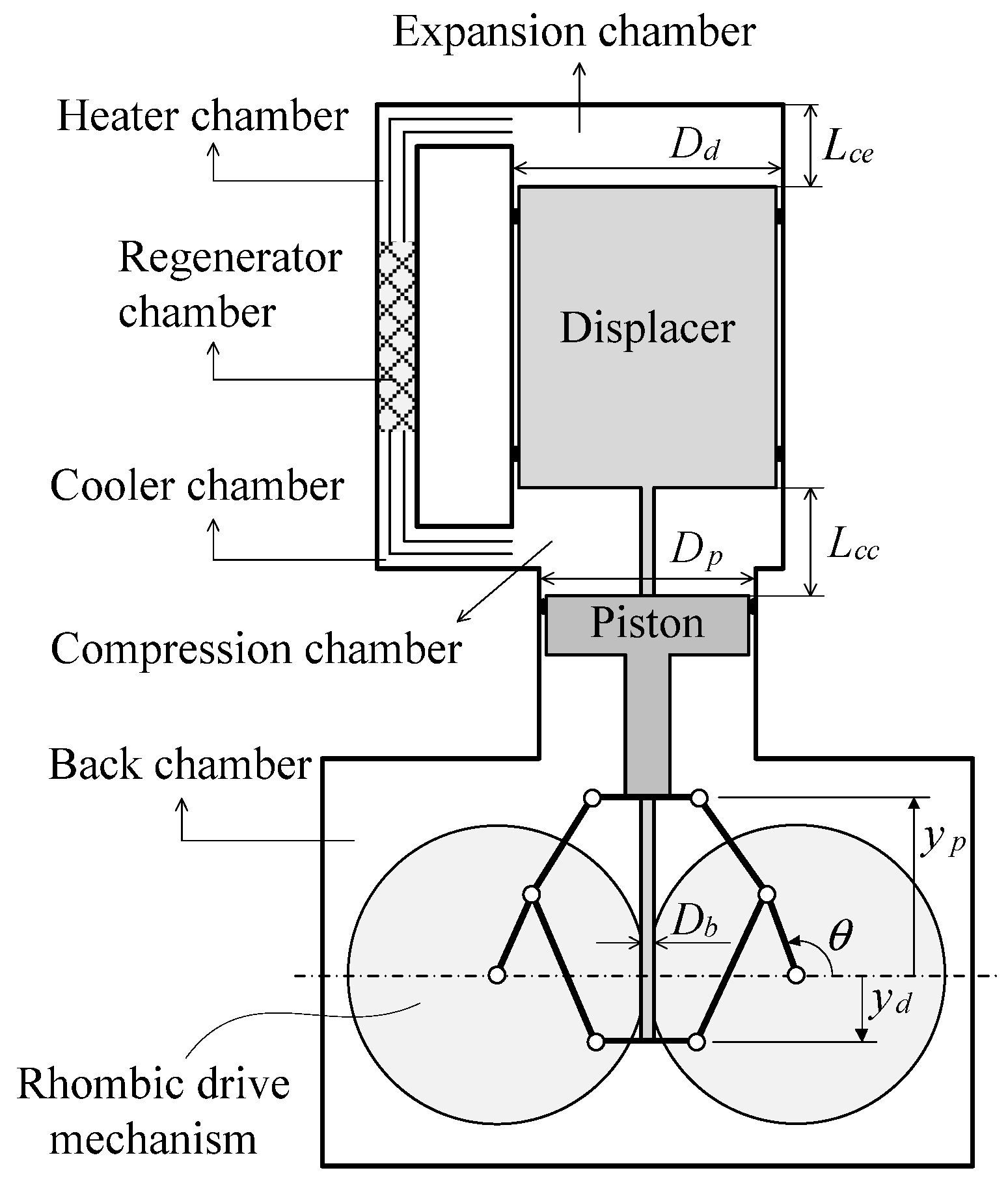
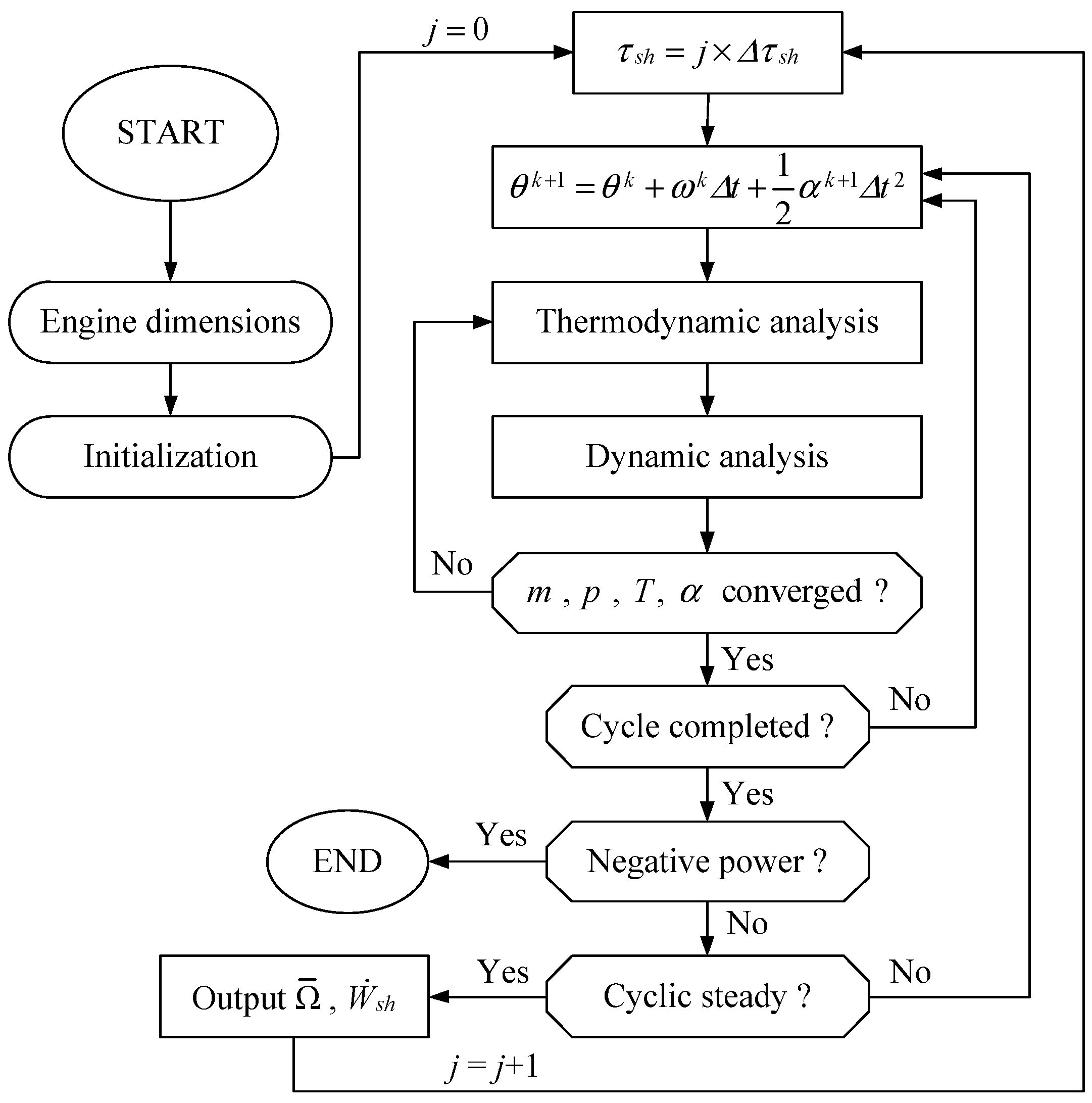
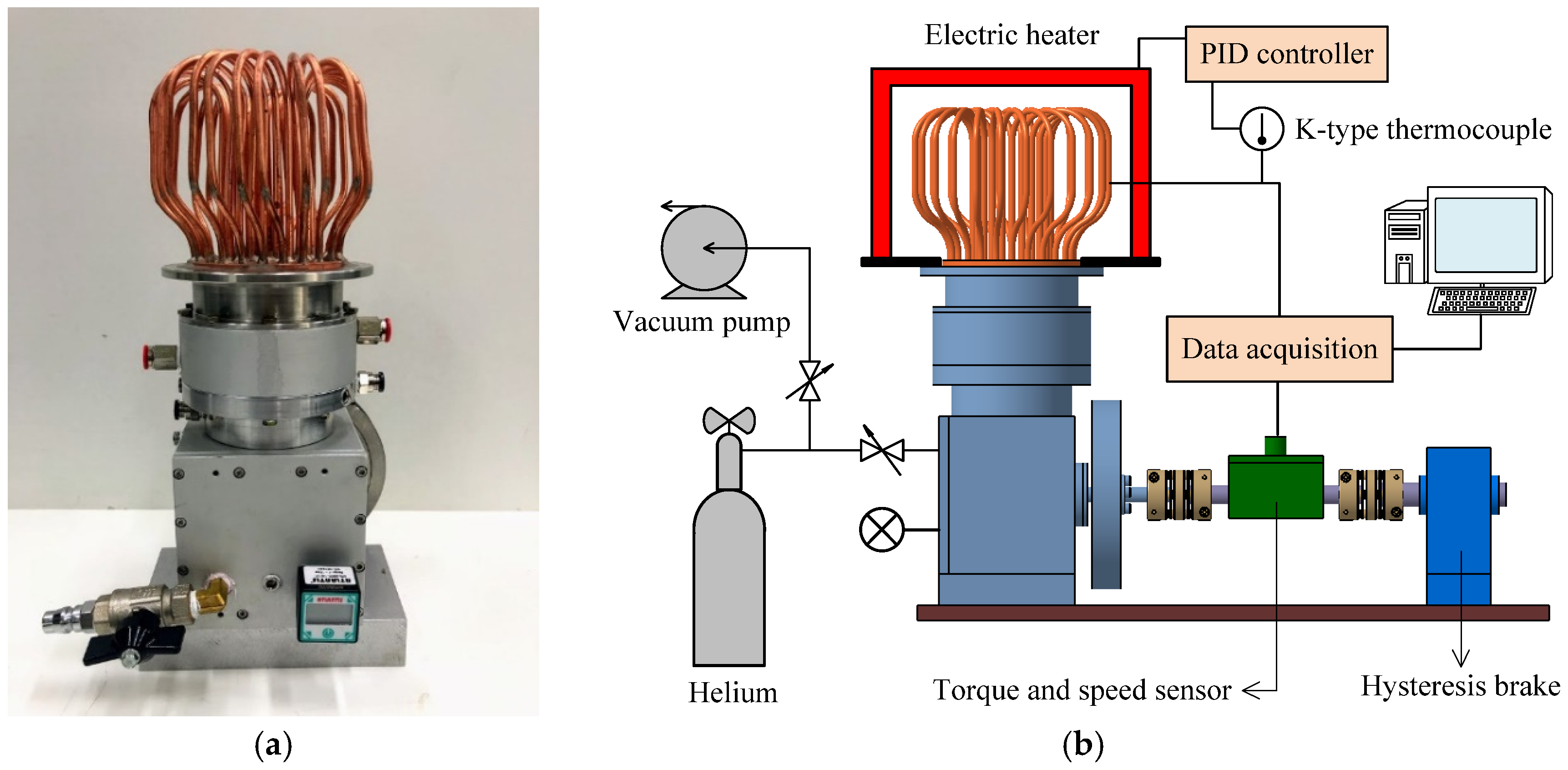
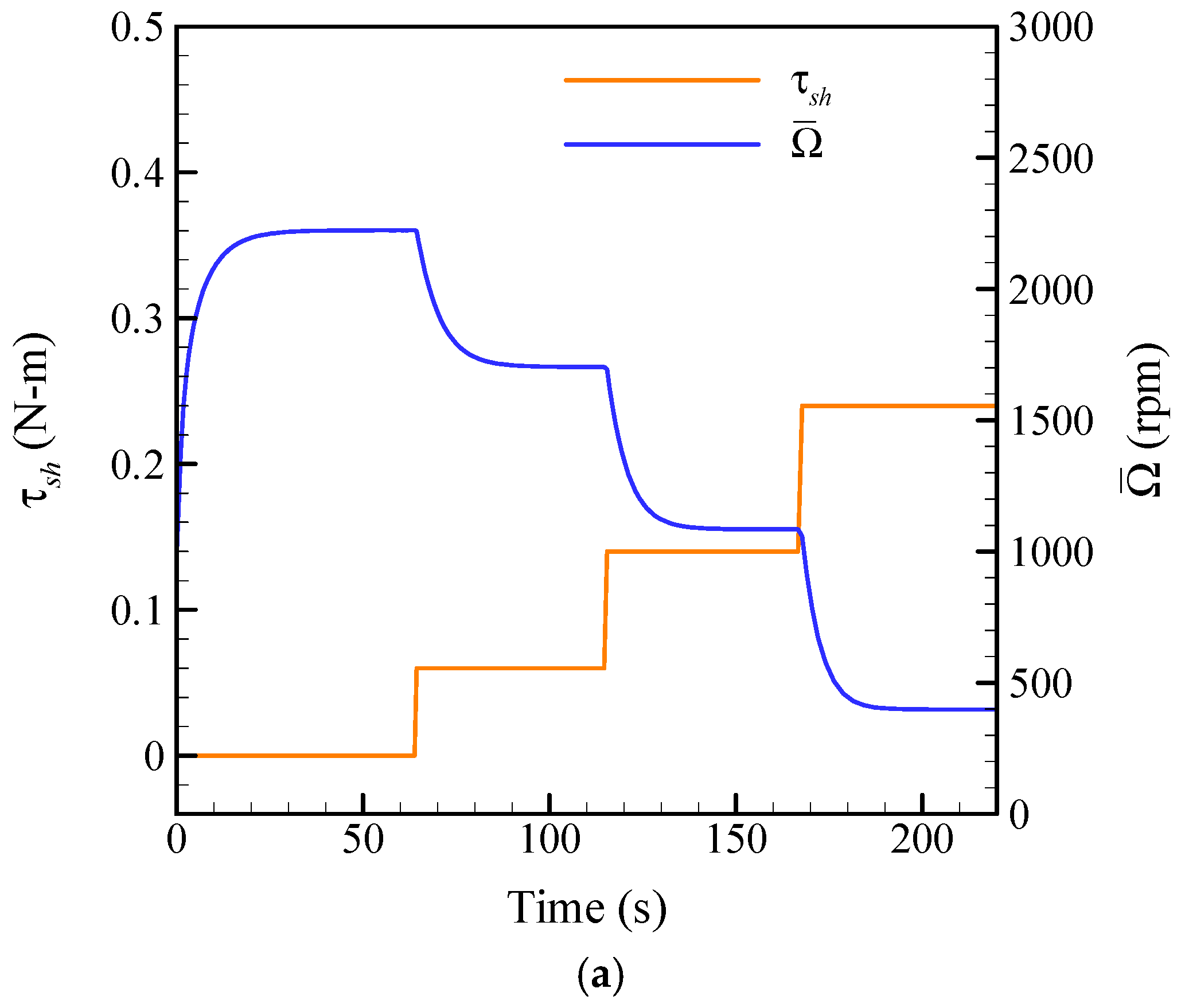
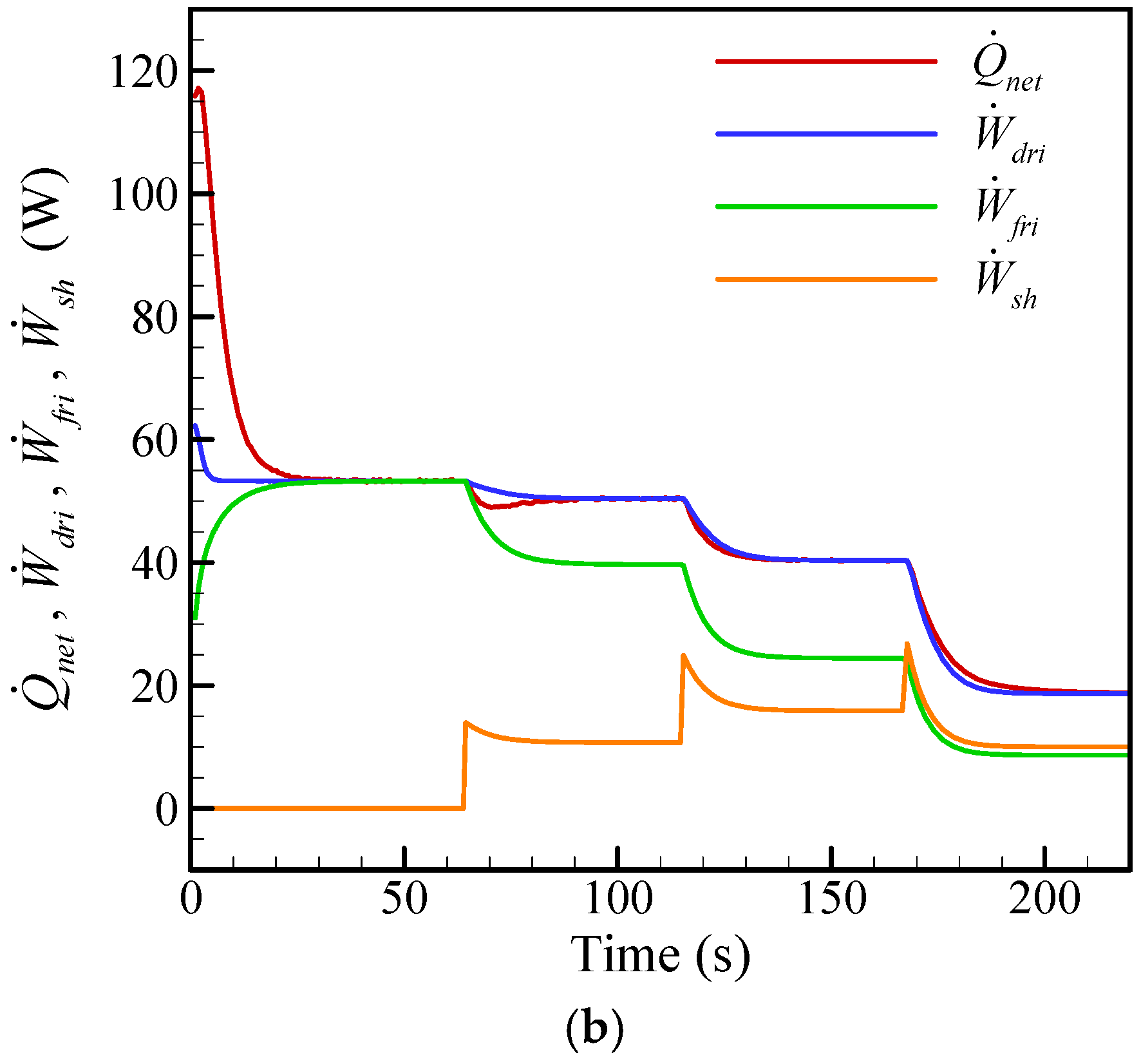


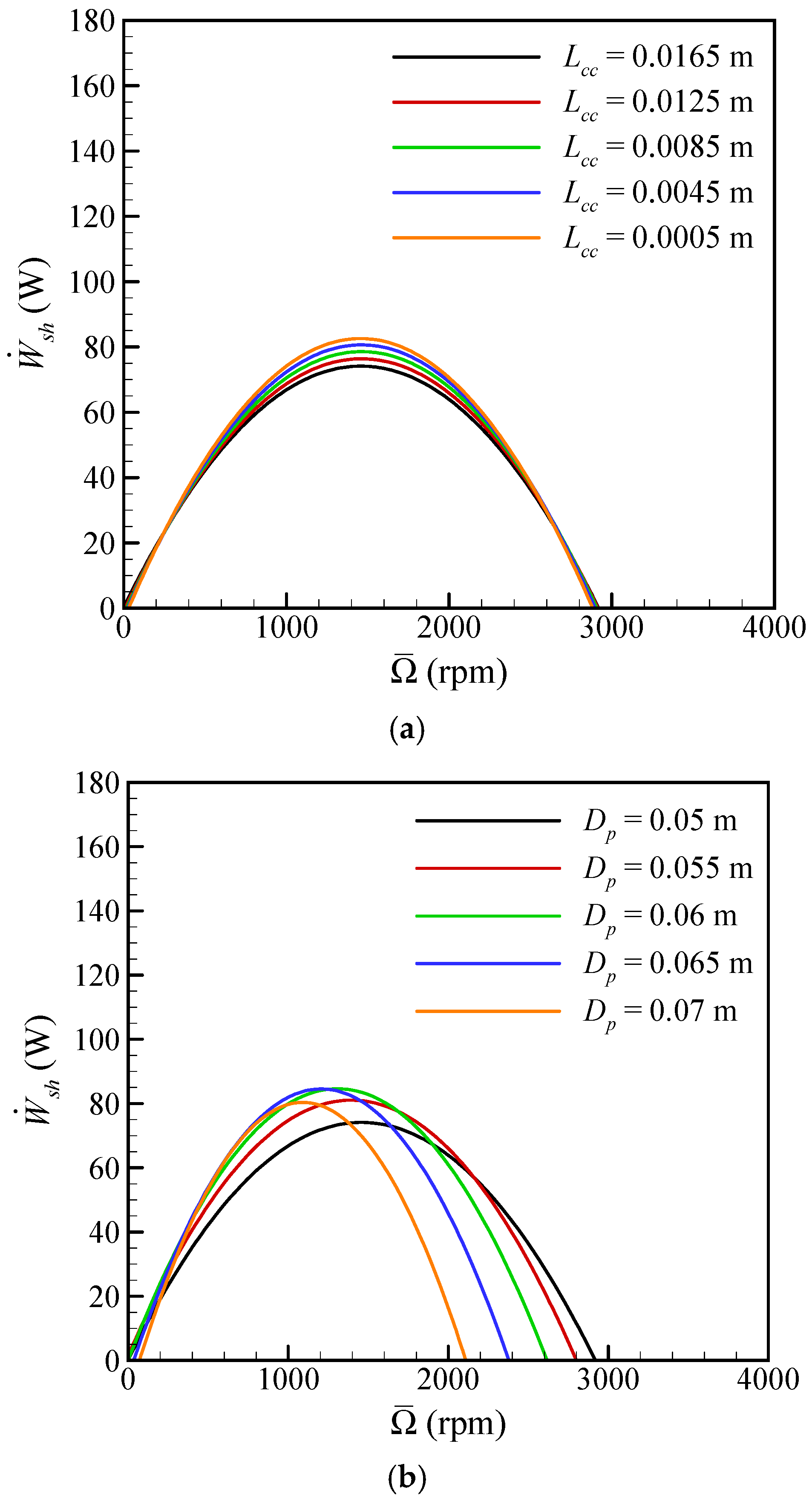
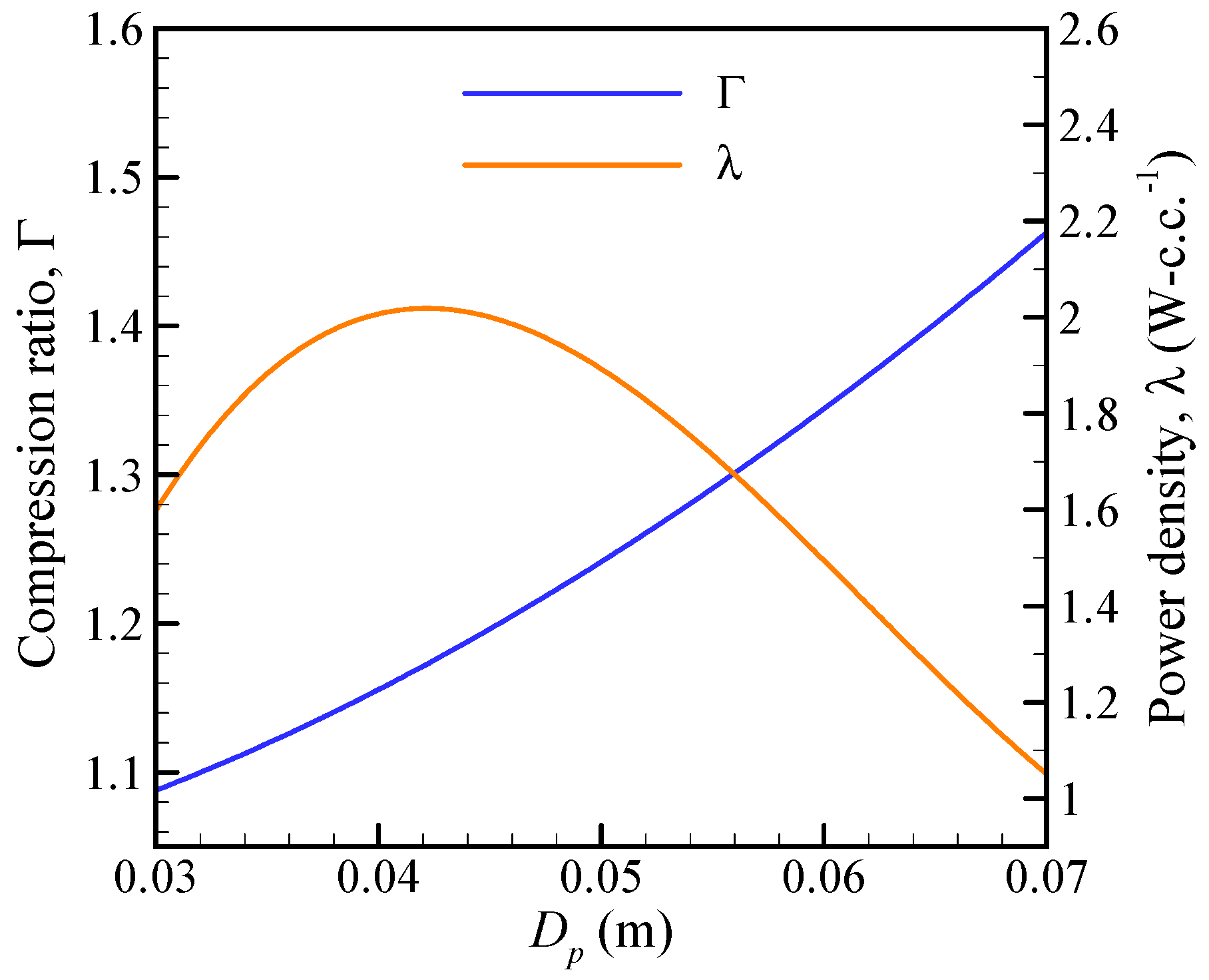
| Displacer Bore × Stroke | 0.07 × 0.0186 m |
| Piston Bore × Stroke | 0.05 × 0.02 m |
| Expansion chamber clearance length, Lce | 0.003 m |
| Compression chamber clearance length, Lcc | 0.0165 m |
| Diameter of back chamber rod, Db | 0.004 m |
| Number of heater channels | 24 |
| Length of heater channel | 0.2345 m |
| Cross-sectional area of heater channel | 8.067 × 10−6 m2 |
| Number of cooler channels | 90 |
| Length of cooler channel | 0.03 m |
| Cross-sectional area of cooler channel | 1.647 × 10−6 m2 |
| Volume of regenerator, Vr | 1.679 × 10−5 m3 |
| Flywheel inertial, If | 7.123 × 10−3 kg-m2 |
| Compression ratio, Γ | 1.242 |
| Charged pressure, pch | 4–8 bar |
| Heating temperature, TH | 773–973 K |
| Gas | Dynamic Viscosity | Thermal Conductivity |
|---|---|---|
| Air | 3.918 × 10−5 Pa-s | 6.099 × 10−2 W-m−1-K−1 |
| Nitrogen | 3.703 × 10−5 Pa-s | 5.844 × 10−2 W-m−1-K−1 |
| Heliuim | 4.073 × 10−5 Pa-s | 3.236 × 10−1 W-m−1-K−1 |
| Hydrogen | 1.837 × 10−5 Pa-s | 7.272 × 10−1 W-m−1-K−1 |
| Parameters | Typical Value, x | Uncertainty a, δx | Relative Uncertainty, δx/x (%) |
|---|---|---|---|
| pch | 4–8 bar | 0.12 bar | 2 |
| TH | 773–973 K | 6.5 K | 0.83 |
| τsh | 0.02–0.28 N-m | 0.004 N-m | 2.7 |
| 350–2700 rpm | 20 rpm | 1.3 | |
| 1–68 W | - | 3.7 b |
| Author | Working Gas | Charged Pressure | Heating Temperature | Power Density |
|---|---|---|---|---|
| Present | Helium | 8 bar | 973 K | 1.725 W-c.c.−1 |
| Aksoy et al. [6] | Helium | 5 bar | 873 K | 0.553 W-c.c.−1 |
| Hirata et al [9] | Nitrogen | 8 bar | 923 K | 0.737 W-c.c.−1 |
| Ni et al. [10] | Helium | 29.6 bar | 808 K | 1.800 W-c.c.−1 |
Publisher’s Note: MDPI stays neutral with regard to jurisdictional claims in published maps and institutional affiliations. |
© 2020 by the authors. Licensee MDPI, Basel, Switzerland. This article is an open access article distributed under the terms and conditions of the Creative Commons Attribution (CC BY) license (http://creativecommons.org/licenses/by/4.0/).
Share and Cite
Cheng, C.-H.; Huang, J.-S. Development of a Beta-Type Moderate-Temperature-Differential Stirling Engine Based on Computational and Experimental Methods. Energies 2020, 13, 6029. https://doi.org/10.3390/en13226029
Cheng C-H, Huang J-S. Development of a Beta-Type Moderate-Temperature-Differential Stirling Engine Based on Computational and Experimental Methods. Energies. 2020; 13(22):6029. https://doi.org/10.3390/en13226029
Chicago/Turabian StyleCheng, Chin-Hsiang, and Jhen-Syuan Huang. 2020. "Development of a Beta-Type Moderate-Temperature-Differential Stirling Engine Based on Computational and Experimental Methods" Energies 13, no. 22: 6029. https://doi.org/10.3390/en13226029







